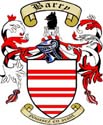Earl of Barrymore

Earl of Barrymore was a title in the Peerage of Ireland. It was created for David Barry, 6th Viscount Buttevant, in 1627/28.[1] Lord Barrymore held the subsidiary titles of Baron Barry (created c. 1261) and Viscount Buttevant (created 1541) in the County of Cork in Ireland. After the death of the 8th Earl in 1823, all these titles became extinct.[2]
The Barrymore title was revived in 1902 in favour of Sir Arthur Smith-Barry, who was created Baron Barrymore in the Peerage of the United Kingdom. He was the grandson of John Smith Barry, illegitimate son of James Hugh Smith Barry (died 1837), son of The Hon. John Smith Barry, younger son of The 4th Earl of Barrymore.[3]
Barons Barry (c. 1261)[]
- (died 1278). In 1267, King Henry III of England appointed Lord David de Barry as Chief Justice of Ireland.[4]
- (died 1285)
- (died 1290)
- (died 1330)
- (died 1347)
- (died 1392)
- (died 1420)
- (died 1480)
- (died 1486)
- (died 1488)
- (died 1500)
- (died 1530)
- (died 1534)
- (1517–1553) (created Viscount Buttevant in 1541)
Viscounts Buttevant (1541)[]
- (1517–1553)
- (died 1556)
- (died 1557)
- James de Barry, 4th Viscount Buttevant (c. 1520–1581)
- David de Barry, 5th Viscount Buttevant (died 1617)
- David Barry, 6th Viscount Buttevant (1604–1642) (created Earl of Barrymore in 1627/28)[5]
Earls of Barrymore (1627/28)[]
- David Barry, 1st Earl of Barrymore (1604–1642)
- Richard Barry, 2nd Earl of Barrymore (1630–1694)
- (1664–1699)
- James Barry, 4th Earl of Barrymore (1667–1747)
- (1717–1751)
- Richard Barry, 6th Earl of Barrymore (1745–1773)
- Richard Barry, 7th Earl of Barrymore (1769–1793)
- (1770–1823)
References[]
- ^ Cokayne, G. E . Complete Peerage Reprinted Gloucester 2000 Vol.1, p. 443
- ^ Cokayne, Vol.1, p. 447
- ^ Cokayne, Vol. XII, p. 16
- ^ Robert Beatson, "A Political Index to the Histories of Great Britain & Ireland", Third edition, London 1806, Volume III, pg 289.
- ^ Cf. Letters Patent for the Earldom of Barrymore 1626/27. In: Frederick Arthur Crisp, Fragmenta Genealogica, vol. X, Private Printing, London 1899, pp. 84–85
See also[]
- De Barry family
- Arthur Smith-Barry, 1st Baron Barrymore of the second creation
Categories:
- Extinct earldoms in the Peerage of Ireland
- De Barry family
- Noble titles created in 1628
- Earls of Barrymore